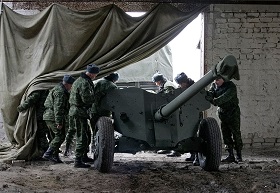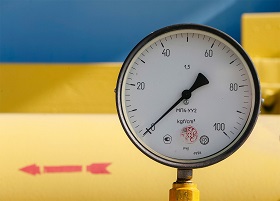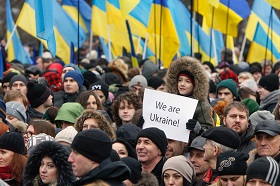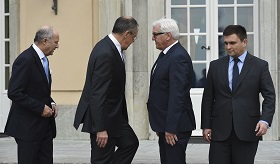Ukraine: 25 Years of Missed Opportunities
In
Login if you are already registered
(votes: 1, rating: 5) |
(1 vote) |
PhD in History, Associate Professor, Department of Post-Soviet Countries, Russian State University for the Humanities, Senior Research Fellow, Institute of Post-Soviet and Interregional Studies
2016 has in many respects been a milestone year for the region that is conventionally referred to as the post-Soviet space. It marks 25 years since the disintegration of the USSR and the creation of the new independent states. Almost everywhere in the region this quarter of a century has been extremely rich in socio-political changes. Ukraine occupies a special place even against this background as a unique example of large-scale transformations. Recent events in the country demonstrate that the very model of Ukrainian statehood is full of hidden traps and pitfalls, and that the Ukrainian elites have in many instances been unable to cope with the mission of ensuring the development of society and the government, which has resulted in a number of serious crises.
2016 has in many respects been a milestone year for the region that is conventionally referred to as the post-Soviet space. It marks 25 years since the disintegration of the USSR and the creation of the new independent states. Almost everywhere in the region this quarter of a century has been extremely rich in socio-political changes. Ukraine, however, occupies a special place even against this background as a unique example of large-scale transformations. On the one hand, by choosing to go with a pluralistic political model at home, and by adhering for a long time to the principles of multifaceted foreign policy, Ukraine managed, at least in the 1990s, to maintain a certain balance of stability. On the other hand, recent events in the country demonstrate that the very model of Ukrainian statehood is full of hidden traps and pitfalls, and that the Ukrainian elites have in many instances been unable to cope with the mission of ensuring the development of society and the government, which has resulted in a number of serious crises.
Economics of Degradation
By the time of the collapse of the USSR, Ukraine ranked second among the Soviet republics in terms of economic potential after Russia. This potential should have objectively been transformed with the country switching to the free-market economy model. Nevertheless, the very transition to that model proved an overall failure. The Ukrainian economy has developed in an obviously non-linear manner since 1991. From the beginning of the 2000s and up until the onset of the global financial and economic crisis, the Ukrainian GDP growth rate averaged around 7.5 per cent annually. In 2010, the country's annual economic growth stood at around 5 per cent, and in 2012 it was registered at 0.3 per cent. Compare this to the period between 1989 and 1999, during which Ukraine’s GDP shrank by nearly 61 per cent.
The very model of Ukrainian statehood is full of hidden traps and pitfalls, and that the Ukrainian elites have in many instances been unable to cope with the mission of ensuring the development of society and the government.
On the whole, however, Ukraine has failed to demonstrate long-term economic growth, unlike its neighbours. It is telling that countries with completely different economic models (for example, Poland or Belarus), which had more or less the same opportunities during the collapse of the Soviet Union and the Eastern bloc, have managed to avoid such crisis situations, despite all their developmental difficulties they have experienced. Poland’s GDP has grown threefold percentage-wise since the early 1990s, compared to Ukraine’s growth of just 63 per cent compared to the 1990 level. This difference is only partially down to the massive assistance that the European Union has given Poland. Belarus, however controversial its economic model, has never experienced anything even close to Ukraine’s economic woes, even though it has seen its share of individual crisis trends due to the unfavourable foreign economic climate of the past few years. Ukraine is down there alongside Moldova as one of the most backward countries in the post-Soviet state in terms of low GDP growth dynamics. The country has been similarly underperforming in terms of the Index of Economic Freedom, net exports, and the level of savings and investment, which has declined by 22.5 per cent over the past three years.
The hostilities in the southeast of the country and the Crimea's secession dealt a massive blow to the Ukrainian economy. As of 2013, Crimea accounted for 3.8 per cent of the country’s combined GDP, while Donbass contributed 16 per cent.

Anton Naychuk:
Domestic Policy-specific Characteristics of
Constitutional Process Implementation in
Ukraine
Russia remains an important trade partner for Ukraine, but its share in the country’s overall trade continues to decline. According to the Federal Customs Service of Russia, Ukraine–Russia trade amounted to $39.6 billion in 2013, making Ukraine the fifth largest trade partner Russia after Germany, Italy, the Netherlands and China. Two years later, the figure had dropped to $14.97 billion, and Ukraine had fallen out of the top 10 of Russia’s largest trade partners. In 2015, trade in commodities and services between Ukraine and Russia stood at $15,990.9 million, which is $10,902.2 million or 40.5 per cent less than in 2014. Mutual trade in commodities alone amounted to $12,315.1 million, down $10,183.1 million or 45.3 per cent from 2014. The 2016 trade in commodities is projected to decline further to $10 billion. The National Bank of Ukraine estimates that the cumulative negative effect of the Russian food embargo (as a protectionist measure in response to the signing the Association Agreement between Ukraine and the European Union) and the restrictions on transit introduced by Russia will amount to $1.1 billion.
Despite the fact that the Association Agreement between Ukraine and the European Union has come into effect, so far it has not had any noticeable positive impact on the country’s economic performance. Even though the agreement is expected to have a delayed effect, the Ukrainian foreign trade crisis continues; the balance of payments is worse than in 2015. In addition, exports are shrinking, particularly in the hi-tech sectors. This downfall has continued in 2016: according to the State Statistics Service of Ukraine, in January–March, Ukrainian exports fell by 11.5 per cent, imports shrank by 6.2 per cent, and the balance of foreign trade went into the red again.
Ukraine has failed to demonstrate long-term economic growth, unlike its neighbours.
Ukraine is experiencing a zero balance of exports and imports with the European Union. The balance used to be negative; however, Ukraine has arrived at the current level at the expense of declining EU imports, rather than as the result of a growth in exports. Nearly 40 per cent of all Ukrainian exports are in the form of agricultural produce; this figure has been growing against the backdrop of a recession in crop farming and cattle breeding, which means that growth is being achieved at the expense of the shrinking mechanical engineering sector and light industry. The share of the processing industry in Ukraine’s overall production profile has shrunk from 30 per cent to 10 per cent over the past 25 years.
With its current extreme reliance on foreign capital injections, the Ukrainian economy is waiting for a decision from the IMF on a new credit tranche. If the country receives what would be its fourth tranche, it will find it easier to stabilize the currency exchange rate, and will be able to ensure a 2–3 per cent economic growth. If, however, it does not receive a fourth tranche (Ukraine had to work hard to secure the previous loan of $1 billion from the IMF, which it then directed to the national gold and currency reserves in order to help stabilize the financial system), then, provided that the National Bank conducts a strict monetary policy and expenses are cut, the dollar exchange rate could be maintained at around 30 hryvnias, and the country could achieve a GDP growth of around 0–1 per cent. In the worst-case scenario, with the National Bank failing to rein in inflation, the political crisis worsening and the IMF refusing to provide Ukraine with another tranche, the possibility of inflation getting out of hand and reaching 25 per cent is fairly high, and this would be accompanied by a GDP decline of up to 2–3 per cent.
Even if the best-case scenario comes to pass, Ukraine remains in economic crisis, despite isolated examples of successful production efforts and business projects launched after 2014. It is becoming increasingly difficult to attribute the lack of any discernible development to the simmering conflict in the southeast of the country, especially given the fairly strong support from international financial structures. Ukraine, which has opted for a single-vector pro-Western course, has not yet realized that replicating the positive elements of the EU economic and administrative system is not the same as living according to the European way of life.
Ukraine still needs to develop the innovative sectors of its economy, improve the tax system, alleviate the fiscal burden, simplify administration and develop the agricultural sector through the production and export of processed products. It is also vitally important to work on both the European and Asian markets, where the Ukrainian presence has also been shrinking. If it does not address these issues, and without intensifying the fight on all-encompassing corruption and the shadow economy (even though the latter has had a certain cushioning effect over the past several years in terms of maintaining the living standard of the population), which have become intrinsic features of the Ukrainian state and society, the country cannot expect to ensure sustained economic growth and overcome the negative trends of the 25 years of its development.
Domestic Policy: Pluralism and Democracy the Ukrainian Way
The history of Ukraine’s domestic political development over the past 25 years is more difficult to assess than its economic situation. While the country’s economic performance does itself provide sufficient evidence enough of the negative trends, the domestic political situation is more complex (it should be noted that Ukraine’s domestic policy is to a large extent to blame for its economic failures).
Russia remains an important trade partner for Ukraine, but its share in the country’s overall trade continues to decline.
On the one hand, Ukraine has managed over the past 25 years to ensure that the electivity of state officials, create a pluralistic political model, and retain the latter in the face of transformations. Leonid Kravchuk, the first President of Ukraine, may be a controversial figure, but his role in creating this system is impossible to deny, as is the role of the post-Soviet Ukrainian elite, which pioneered the country’s statehood by ensuring the introduction and implementation of these processes for the sake of uniting the variegated regions of the country and helping establish the rules of the game, which continued to work throughout the 1990s despite all the difficulties. Back then, despite all the problems of the Ukrainian political system, the country’s parliament was more responsible and professional than it is now, both in terms of its composition and the lobbying rules. This, however, was to a great extent down to the Soviet legacy. Ukraine as a new independent state never got down to introducing an efficient model of domestic political development, despite having such critical post-Soviet instruments and competitive elections at its disposal.

Vostock Photo
Anton Naychuk:
Development Scenarios for the Conflict in
Eastern Ukraine: A View from Kiev
The Ukrainian elite of the early 1990s was a symbiosis of Soviet ideocratic and technocratic tendencies. This symbiosis was governed by a system of checks and balances, including between the country’s eastern and western regions, which helped keep the situation in relative balance. However, there were other trends gaining strength in the country virtually from the very beginning of the 1990s; the new independent Ukraine, which was pursuing the goal of building a young state, ran into a plethora of challenges and failed to handle them.
The most important problem was that of negative selection: the country’s political and economic elites gradually degraded throughout the 1990s, and the system started to transform into a specific kind of oligarchic capitalism characterized by social stratification, the enrichment of the top handful of people, the absence of social responsibility, and the desire to use power exclusively for personal gain.
All this was accompanied by unprecedented infrastructural degradation, growing corruption, demographic decline and emigration among the most active categories of the population, primarily the youth. It was this profound social crisis that caused the events which are now known as the Orange Revolution or the First Maidan.
Another important negative trend was the gradual growth of nationalist sentiments, which were to a certain extent fuelled by the desire of the powers that be to use this trend for their own interests. The nationalist moods correlated conveniently with Ukraine’s drive towards shedding its imperial and Soviet legacy completely, and played a role in the gradual reduction of humanitarian and cultural contacts with Russia, accompanied by mistakes in Russia's “soft power” policy with regard to Ukraine. All these factors combined to produce a severe cumulative effect, which created the preconditions for the current breakup.
Nearly 40 per cent of all Ukrainian exports are in the form of agricultural produce; this figure has been growing against the backdrop of a recession in crop farming and cattle breeding, which means that growth is being achieved at the expense of the shrinking mechanical engineering sector and light industry.
The evolution of the domestic political situation in Ukraine demonstrates that elections and a ramified system of political parties, while certainly being important, do not necessarily guarantee the creation of a modern democracy if accompanied by a permanent economic crisis and the complete dissociation of the elites from the interests of the country’s strategic development. Quite the contrary, in the Ukrainian system they facilitated the coming to power of people who proved incapable of running a country and were only good at creating and enriching their own clans, which would often be formed on a territorial basis.
To many in Ukraine, the Euromaidan events turned into an attempt to carry our personal purification. This attempt, however, came at a colossal cost. It may have changed a significant portion of society to a great extent, but it has not yet done the same to the powers that be, which are still represented by the same old personalities, with the rare exception of some new faces. New figures have certainly emerged; many of these have achieved certain success regionally. They represent the younger generation and the future of Ukraine will depend on them to a great extent. However, their success or failure will depend on whether the political class can find a new sense of responsibility and develop an effective development programme, which would not only proclaim a pro-Western course, but also lay the foundations for modernization within the country, using the European standards and rules as a means to this end rather than an end in itself.
It is very important for Ukraine to change its perception of Russia in the coming years. This goal, however unfathomable it may appear at the moment, is fairly attainable, but reaching it will require time and effort. In this sense, everything will depend on how quickly Ukraine manages to switch from the confrontational and defensive phase in its work to form a political nation to a peaceful and constructive one. This also depends on the positions of all the external actors involved in the Ukrainian crisis, and also on Russia. Now that the post-Soviet stage of Ukraine’s history is over, the question that country’s political class is facing can no longer be answered in a manner that was characteristic for the 1990s and the 2000s, because the very existence and future of the Ukrainian state are at stake.
Foreign Policy Dynamics
Ukraine’s post-Soviet foreign political model has been more dynamic over the past 25 years than its domestic and economy policies. It has evolved since its establishment into a multfaceted model, with European integration its fundamental goal. Back in the 1990s, even without being fully integrated into the CIS, Ukraine managed to maintain relations with Russia and conduct an overall balanced policy. Now, however, European integration has not only largely supplanted the country’s relations with Russia, but it has also stripped Ukrainian foreign policy of its flexibility.
Despite the fact that Ukraine’s foreign policy was more balanced back then than it is today, Ukraine had already set course towards building closer ties with the West and distancing itself from Russia in the 1990s. It was then that many of Kiev’s current foreign policy positions were conceived. Under President Leonid Kuchma, foreign policy in post-Soviet Ukraine experienced a boom period. It was largely thanks to Kuchma’s pro-Russian rhetoric that he was elected president in the first place. He managed (temporarily, as it later turned out) to mitigate the desire of the Crimean people to integration with Russia; he also managed, in 1997, to complete the division of the Black Sea Fleet, and to finally sign the Treaty on Friendship, Cooperation and Partnership between the Russian Federation and Ukraine. On the other hand, even Kuchma’s presidency cannot be appraised unambiguously. This especially concerns his second tenure when, in the 1999 election, he campaigned as a pro-Western president. It was under Kuchma that Ukraine took its first steps towards NATO by signing the NATOU–Ukraine Action Plan and the foundation was laid for the subsequent rapprochement with the European Union. It was also under Kuchma that Ukraine became a member of the GUAM (formerly GUUAM) Organization for Democracy and Economic Development, an integration structure aimed at minimizing Russia’s influence over the post-Soviet space.
Ukraine remains in economic crisis, despite isolated examples of production efforts and business projects launched after 2014. It is becoming increasingly difficult to attribute the lack of any discernible development to the simmering conflict in the southeast of the country, especially given the fairly strong support from international financial structures.
Later, after the Orange Revolution, Ukraine took a clear course towards closer partnership with the West. The gas wars and the territorial dispute involving Tuzla Island that preceded it, further complicated Russia–Ukraine relations. The signing of the Agreement between Ukraine and Russia on the Black Sea Fleet in Ukraine (also known as the Kharkiv Pact or the Kharkiv Accord) under President Viktor Yanukovych was more of a tactical step on the part of Ukraine, whose multifaceted foreign political traditions deteriorated under Yanukovych to a policy of outright bargaining [1].
Ukraine’s foreign policy has taken on a strictly pro-Western character since Euromaidan, and it is now facing a plethora of challenges. First, Ukraine, which is perceived – particularly in the United States – as a geopolitical frontier, is in essence a dependent country whose international subjectivity has been seriously weakened, especially by the fact of its financial dependency. Ukraine mainly plays the anti-Russian card in the international arena, striving to show its importance in deterring Russia instead of acting within a meaningful agenda.
The second important trend is that, despite the fact that many people in Ukraine were expecting a plan for EU membership or visa-free travel, Kiev’s European partners have by now made it clear that the first issue is off the table, while the visa-free regime has not been introduced despite the fact that Ukraine has met a significant portion of the very stringent preliminary conditions. One of the recent and most widely cited statements on the topic include the admission by the President of the European Commission Jean-Claude Juncker that Ukraine will not become an EU member within the next 25 years. The Ukraine question has gradually started to fade into the background in terms of European, U.S. and even Russian media coverage. Europe, which faces a number of problems of its own, is growing tired of the topic, especially with regard to speculation about the possibility of Ukraine becoming an EU member.
Third, Kiev is experiencing growing pressure from its European partners on the implementation of the Minsk Agreements. The emergence of the Morel Plan, the Steinmeier Formula, and the unambiguous position of Germany and France on the need to hold elections in Donbass send a clear signal in this respect. Much will depend now on the creation of a roadmap based on the latest meeting of the Normandy Format heads of state in Berlin. But the prospects of a frozen conflict are still very real, and such an outcome cannot suit the European side.
Back then, despite all the problems of the Ukrainian political system, the country’s parliament was more responsible and professional than it is now, both in terms of its composition and the lobbying rules. This, however, was to a great extent down to the Soviet legacy.
One indirect indication of European public opinion on the Ukrainian issue was the Dutch referendum on ratifying the Association Agreement between Ukraine and the European Union. The outcome of the referendum suggests that the image of Ukraine in Europe is not as strong as Kiev would have liked. The referendum also clearly showed that the European people had grown tired of the initiatives and style of Brussels bureaucracy. Despite the fact that Kiev enjoys close political ties with Washington and Europe is limited in its ability to force Kiev implement the political portion of the Minsk Agreements, the very position of Germany, France and a number of other European states has largely changed the perception within Ukraine of its pro-EU vector. It is becoming increasingly clear that this road will be far from easy, and that Ukraine will need to do a lot in order to achieve at least tactical results.
Fourth, Kiev’s exclusive orientation towards Brussels is one of the primary downsides of Ukraine’s contemporary foreign policy. Kiev justly believes Brussels to be an important partner, capable of both providing financial assistance and facilitating the introduction of visa-free travel. However, in believing so, Ukraine has obviously neglected bilateral contacts; any attempts to engage in such relations have been sporadic and have usually resulted in little success. This comes against the background of growing trend towards re-establishing the primacy of sovereignty, both in Europe and around the world, and the increasing dissatisfaction with Brussels not only on the public level, but also among national political elites. This makes bilateral relations all the more important to Kiev in terms of its interaction with neighbouring countries. Many Ukrainian regions border foreign states, meaning that the country has great transit potential. And its very geography makes it a country of cooperation rather than one of self-containment.
Nevertheless, Ukraine has achieved little systemic success in developing such relations, although certain efforts have indeed been made. Both the individuals in charge of the country’s foreign policy and the expert community are gradually coming to realize the necessity, if not of a complete return to a multifaceted approach, then at least of following other vectors in its policies in addition to the Western vector that currently dominates. Ukraine is also starting to understand how important many post-Soviet countries are to the country.
1. Foreign Policy of the New Independent States: Almanac // Editor-in-Chief B.A. Shmelev. Moscow: Institute of Economics of the Russian Academy of Sciences, 2015, p. 240
(votes: 1, rating: 5) |
(1 vote) |







